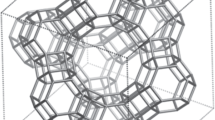Abstract
A method that explains how to quantify the amount of order in “ordered” and “highly ordered” porous arrays is derived. Ordered arrays from bee honeycomb and several from the general field of nanoscience are compared. Accurate measures of the order in porous arrays are made using the discrete radial distribution function (RDF). Nanoporous anodized aluminum oxide (AAO), hexagonal arrays from functional materials, hexagonal arrays from nanosphere lithography, and square arrays defined by interference lithography (all taken from the literature) are compared to two-dimensional model systems. These arrays have a range of pore diameters from ∼60 to 180 nm. An order parameter, OP 3 , is defined to evaluate the total order in a given array such that an ideal network has the value of 1. When we compare RDFs of man-made arrays with that of our honeycomb (pore diameter ∼5.89 mm), a locally grown version made by Apis mellifera without the use of foundation comb, we find OP 3 =0.399 for the honeycomb and OP 3 =0.572 for man’s best hexagonal array. The nearest neighbor peaks range from 4.65 for the honeycomb to 5.77 for man’s best hexagonal array, while the ideal hexagonal array has an average of 5.93 nearest neighbors. Ordered arrays are now becoming quite common in nanostructured science, while bee honeycombs were studied for millennia. This paper describes the first method to quantify the order found in these arrays with a simple yet elegant procedure that provides a precise measurement of the order in one array compared to other arrays.



Similar content being viewed by others
References
Barrett S (2006) The web site of Image SXM. http://www.liv.ac.uk/∼sdb/ImageSXM/. December 2005
Behnke JF, Sands T (2000) Bimodal spatial distribution of pores in anodically oxidized aluminum thin films. J Appl Phys 88(11):6875
Betts AD (1921) The structure of comb-I. Bee World 3:37
Bocharov GS, Eletskii AV (2005) Effect of screening on the emissivity of field electron emitters based on carbon nanotubes. Tech Phys 50(7):944
de Levie Robert (2004) Advanced excel for scientific data analysis. Oxford University Press, London, UK
Hales TC (2001) The honeycomb conjecture. Discrete Comput Geom 25:1
Haynes CL, Van Duyne RP (2001) Nanosphere lithography: a versatile nanofabrication tool for studies of size-dependent nanoparticle optics. J Phys Chem B 105:5599
Hepburn HR, Whiffler LA (1991) Construction defects define pattern and method in comb building by honeybees. Apidologie 22:381
Hu Y, Huang CH (2003) Computer simulation of the field emission properties of multiwalled carbon nanotubes for flat panel displays. J Vac Sci Technol B 21(4):1648
Hulteen JC, Treichel DA, Smith MT, Duval ML, Jensen TR, Van Duyne RP (1999) Nanosphere lithography: size-tunable silver nanoparticle and surface cluster arrays. J Phys Chem B 103:3854
Krishnan R, Nguyen HQ, Thompson CV, Choi WK, Foo YL (2005) Wafer-level ordered arrays of aligned carbon nanotubes with controlled size and spacing on silicon. Nanotechnology 16:841
Li AP, Müller F, Birner A, Nielsch K, Gösele U (1998a) Hexagonal pore arrays with a 50–420 nm interpore distance formed by self-organization in anodic alumina. J Appl Phys 84(11):6023
Li F, Zhang L, Metzger RM (1998b) On the growth of highly ordered pores in anodized aluminum oxide. Chem Mater 10:2470
Li J, Papadopoulos C, Xu JM, Moskovits M (1999) Highly-ordered carbon nanotube arrays for electronics applications. Appl Phys Lett 75:367
Mikhailov SA (1996) Radiative decay of collective excitations in an array of quantum dots. Phys Rev B 54(15):10335
Park KH et al (2005) Advanced nanosphere lithography for the areal-density variation of periodic arrays of vertically aligned carbon nanofibers. J Appl Phys 95:024311
Pirk CWW, Hepburn HR, Radloff SE, Tautz J (2004) Honeybee combs: construction through a liquid equilibrium process? Naturwissenschaften 91:350
Sellmyer DJ, Zheng M, Skomski R (2001) Magnetism of Fe, Co and Ni nanowires in self-assembled arrays. J Phys Condens Matter 13:R433
Shinada T, Okamoto S, Kobayashi T, Ohdomari I (2005) Enhancing semiconductor device performance using ordered dopant arrays. Nature 437:1128
Sun F, Cai W, Li Y, Cao B, Lei Y, Zhang L (2004) Morphology-controlled growth of large area two-dimensional ordered pore arrays. Adv Funct Mater 14(3):283
Toth LF (1964) What the bees know and what they do not know. Bull Am Math Soc 70:469
von Frisch Karl (1974) Animal architecture. Harcourt Brace Jovanovich, New York
Acknowledgements
This research is indebted to Steve Barrett and his efforts with Image SXM for Mac OS X, which was used to determine the areas and coordinates for all the arrays. F.H. Kaatz would like to acknowledge the excellent library services at Owens Community College, the University of Toledo, and Sandia National Laboratories. The honeycomb used in this study was purchased from Sawyer’s Apiaries, Swanton, OH 43558, USA. F.H. Kaatz thanks P. Kaatz, T. Egami, and M.P. Siegal for a critical review of the manuscript.
Author information
Authors and Affiliations
Corresponding author
Rights and permissions
About this article
Cite this article
Kaatz, F.H. Measuring the order in ordered porous arrays: can bees outperform humans?. Naturwissenschaften 93, 374–378 (2006). https://doi.org/10.1007/s00114-006-0118-x
Received:
Accepted:
Published:
Issue Date:
DOI: https://doi.org/10.1007/s00114-006-0118-x




